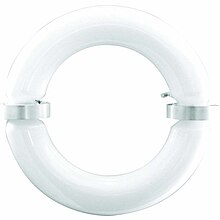Induction lamp
An induction lamp is a special fluorescent lamp or fluorescent tube that couples the energy in electromagnetically and whose gas container therefore has no electrodes .
technology
Induction lamps differ fundamentally in structure from conventional fluorescent lamps. While in fluorescent lamps electrodes protrude into the interior of a gas-filled glass tube and the high electrical voltage between them leads to an ionization of the gas, in induction lamps no live parts come into contact with the gas filling. The energy is transferred to the gas filling according to the electromagnetic induction principle.
The low-pressure gas discharge inside is not fed via electrodes, as is the case with conventional fluorescent tubes, but is maintained by inductive coupling. For this purpose, the discharge vessel forms the secondary winding of a transformer . The windings of these excitation coils are fed with a special ballast (better control gear ) with a high-frequency alternating voltage, which is generated from the mains voltage or from a direct voltage (e.g. for emergency lighting ).
In contrast to excitation with microwaves (e.g. sulfur lamp ), the operating frequency of the open designs is relatively low at approx. 250 kHz. Because of this, and because of the mostly symmetrical structure, less shielding expenditure against interference emissions is required than with microwave excitation.
Compact induction lamps with working frequencies around 2.65 MHz have a rod-shaped, so-called power coupler (coil) inside. They sometimes have a thin, electrically conductive layer or wire rings on their outer shell in order to keep noise emissions to a minimum.
Induction lamps have external HF generators or, in the case of low outputs, integrated into the lamp and are offered with outputs from 23 to 500 watts.
The light yields are 60 to 90 lumens per watt, based on the light that can actually be perceived by the human eye, up to 150 pupil lumens per watt (so-called VEL value).
Because of their high purchase price, induction lamps have so far mainly been used in areas in which a high level of reliability is required and changing the lamp requires a great deal of effort or is impossible. In some cases, lifetimes of 100,000 hours and maintenance-free for over 10 years are guaranteed.
However, the declared values are not always achieved. In 1994 , for example, the Swiss metropolis of Zurich experimentally installed six street lights with induction lamps in the city, which, according to the manufacturer, promised lower maintenance costs compared to other lamp types thanks to a long service life, according to the manufacturer. In 2014, after 20 years of operation, it was decided not to introduce this technology because the promised service life did not meet expectations. The lanterns are to be dismantled after the spare parts that are still available and are no longer available.
Induction lamps, like conventional fluorescent lamps, are available in different color temperatures and very good color rendering indices thanks to the choice of phosphors .
Designs
Open design
The feeding winding in this design consists of two narrow, wound toroidal cores that are placed around the self-contained tube. The basic structure is similar to that of a tokamak . The discharge vessel has the shape of a self-contained fluorescent lamp with two parallel tubes. The length of a 150 watt unit is about 500 mm.
Compact design
There are induction lamps for E27 and E40 screw sockets, which can therefore be used as a replacement for conventional lamps. In these lamps, the inductive excitation takes place via a cylindrical coil in the middle of the discharge vessel. The coil is fed by integrated electronics or by an external high-frequency generator.
advantages and disadvantages
- advantages
compared to fluorescent lamps are:
- Flicker-free instant start
- switchable, therefore with motion detectors or similar. can be used - also for security areas
- high luminous flux over a wider temperature range ( amalgam as mercury reservoir )
- lower possible ignition temperature (with suitable ballasts down to −40 ° C)
- high luminous efficacy of up to 120 lm / W with a very good color rendering index
- 100,000 operating hours and more possible (more than 10 years).
- tolerated by nocturnal insects due to largely natural light spectrum
According to the manufacturer, 75% and 60% of the light intensity can still be achieved after 60,000 or 70,000 hours.
- disadvantage
- Often a special luminaire with ballast is required, often no base compatible with other lamps
- high purchase price (now available at moderate prices, including as a conversion kit for existing lights)
- Lamps (like fluorescent lamps) contain mercury - problematic in the event of mechanical destruction and recycling or improper disposal.
Individual evidence
- ↑ IQL induction lighting. Information from the IMT company ( Memento from July 16, 2012 in the Internet Archive ).
- ↑ Martin Huber: The unique lamp from Helvetiaplatz. In: Tages-Anzeiger . July 15, 2014, accessed July 20, 2014 .
- ↑ Data sheet ( memento of October 7, 2009 in the Internet Archive ) from Osram
- ↑ Data sheet ( Memento from June 21, 2011 in the Internet Archive ) from Osram
- ↑ Information from the Luxim company ( Memento from February 7, 2009 in the Internet Archive )
- ↑ data sheet from Leuchtec

